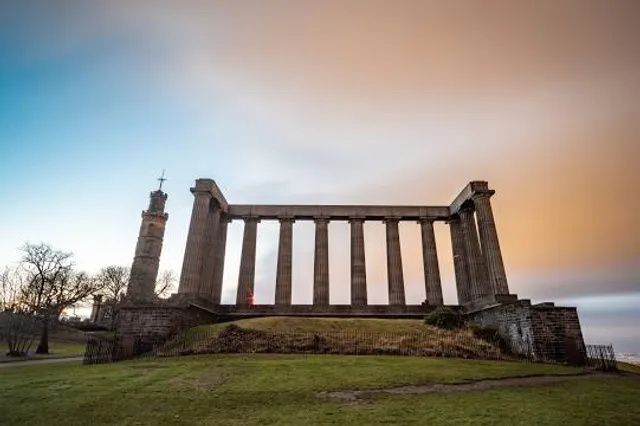National Monument of Scotland things to do, attractions, restaurants, events info and trip planning

Basic Info
National Monument of Scotland
Calton Hill, Edinburgh EH7 5AA, United Kingdom
4.7(1.1K)
Open 24 hours
Save
spot
spot
Ratings & Description
Info
The National Monument of Scotland, on Calton Hill in Edinburgh, is Scotland's national memorial to the Scottish soldiers and sailors who died fighting in the Napoleonic Wars. It was intended, according to the inscription, to be "A Memorial of the Past and Incentive to the Future Heroism of the Men of Scotland".
Cultural
Outdoor
Scenic
Family friendly
attractions: Nelson Monument, Dugald Stewart Monument, Edinburgh Playhouse, Burns Monument, Museum of Edinburgh, Dunbars Close, The Chocolatarium, The People's Story Museum, St Mary's Catholic Cathedral, Palace of Holyroodhouse, restaurants: Howies Waterloo Place, COSMO All You Can Eat World Buffet Restaurant | Edinburgh, Edinburgh Street Food, Cafe Calton, Slug & Lettuce - Omni Centre Edinburgh, LYLA, Tony Macaroni - Omni Centre, Maki & Ramen, Nando's Edinburgh - Omni Centre, Society Bar & Kitchen
 Learn more insights from Wanderboat AI.
Learn more insights from Wanderboat AI.Website
ewh.org.uk
Plan your stay

Pet-friendly Hotels in City of Edinburgh
Find a cozy hotel nearby and make it a full experience.

Affordable Hotels in City of Edinburgh
Find a cozy hotel nearby and make it a full experience.

The Coolest Hotels You Haven't Heard Of (Yet)
Find a cozy hotel nearby and make it a full experience.

Trending Stays Worth the Hype in City of Edinburgh
Find a cozy hotel nearby and make it a full experience.
Reviews
Nearby attractions of National Monument of Scotland
Nelson Monument
Dugald Stewart Monument
Edinburgh Playhouse
Burns Monument
Museum of Edinburgh
Dunbars Close
The Chocolatarium
The People's Story Museum
St Mary's Catholic Cathedral
Palace of Holyroodhouse

Nelson Monument
4.6
(1.1K)
Open 24 hours
Click for details

Dugald Stewart Monument
4.7
(496)
Open 24 hours
Click for details

Edinburgh Playhouse
4.4
(2.5K)
Open 24 hours
Click for details

Burns Monument
4.4
(198)
Open 24 hours
Click for details
Things to do nearby

Uncover Edinburghs old town
Thu, Jan 8 • 10:30 AM
Edinburgh, EH1 1RF, United Kingdom
View details

Ride to Loch Ness, Glencoe, and the Highlands
Thu, Jan 8 • 8:00 AM
Edinburgh, EH1 2EL, United Kingdom
View details

The Dark Side of Edinburgh
Thu, Jan 8 • 8:00 PM
Edinburgh, EH1 2JU, United Kingdom
View details
Nearby restaurants of National Monument of Scotland
Howies Waterloo Place
COSMO All You Can Eat World Buffet Restaurant | Edinburgh
Edinburgh Street Food
Cafe Calton
Slug & Lettuce - Omni Centre Edinburgh
LYLA
Tony Macaroni - Omni Centre
Maki & Ramen
Nando's Edinburgh - Omni Centre
Society Bar & Kitchen

Howies Waterloo Place
4.5
(1.8K)
Click for details

COSMO All You Can Eat World Buffet Restaurant | Edinburgh
4.3
(3.3K)
$$
Click for details

Edinburgh Street Food
4.6
(1.1K)
$
Click for details

Cafe Calton
4.1
(101)
Click for details







